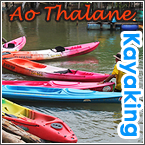Beads Of Lasting Heritage And Pride
September 19, 2009 by admin
Filed under Related Interests
Captain Boonyarit Chaisuwan raises awareness on illegal bead hunting and the importance of conservation of artefacts
The sky was still dark when Captain Boonyarit Chaisuwan, an archaeologist of the Phuket-based 15th Fine Arts Office, readied himself for another mission. His destination: Ban Dan School, in Kapoe district, Ranong province. The archaeologist was to meet with a group of 40 students and teachers from the school who took part in a heritage conservation project in which participants attended archaeological workshops, as well as an excavation process. The project is the brainchild of Capt Boonyarit in a bid to promote conservation awareness in communities close to key archeological sites on the Andaman coast of southern Thailand. Ban Dan School and Wat Pathum Tararam were chosen because of their rice heritage, he said. The archaeologist said the project, which ended earlier this month, was to serve as a model for conservation awareness campaigns.
“Bead hunting has become rampant in the area and we need to do something about it,” he said, adding that his project was only an initial, but crucial, step to protect the local heritage since crackdown alone was not enough. The archaeologist noted that the bead hunters turned to Kapoe and other archeological areas, including Phu Khao Thong village in Ranong’s Suk Samran district, because they had already exhausted most of the resources at Kuan Lukpad in Krabi’s Khlong Thom district. Kuan Lukpad, which literally means “Hill of Beads”, was well-known for its various types of beads, in particular, the face bead or the so-called “Suriya Dev” and Roman carnelian intaglio, featuring Peseus holding the head of Medusa. The craze for
beads led to widespread illegal bead hunting over the past 30 years. Since every square metre had been scoured by local villagers who made a fortune selling beads to collectors, it is believed that there were no ancient beads left in the area and the “Hill of Beads” is just one on the list. “The Kuan Lukpad phenomenon is a precious lesson for every community with archaic artefacts,” said Capt Boonyarit, stressing that he didn’t want other areas to ever repeat the same mistake. That prompted him to launch the first project at Phu Khao Thong village in 2006, which raised awareness among the local people and encouraged them to better safeguard their heritage. In his article, Archaeology along the Andaman Coast, which was recently presented at an international seminar on Thai-Malaysian Archaeology Joint
Project, Capt Boonyarit pointed out that Phu Khao Thong is still largely unknown to scholars but is no less important to Kuan Lukpad. Some 2,000 years ago, Kuan Lukpad and Phu Khao Thong were both once prosperous port cities and trading stations where people exchanged goods with foreigners from Southeast Asia, the Middle East and Europe along the so-called “Southern Silk Route”. More importantly, he noted that archaeological evidences, in particular, clumps of glass and stone, as well as unfinished beads that were found in drove, indicated that both cities were not just bead trading stations as previously believed by many Western scholars, but major bead-making sites of the region. Other exquisite findings at Phu Khao Thong archaeological sites included gold ornaments – also in
large amounts – from the Middle East; carnelian triratana beads, a symbol of Buddhism; and some Rouletted ware, a kind of pottery with a smooth surface. It was the first time that Rouletted ware (c. 2nd century BC to 1st century AD) was discovered on Thailand’s Andaman coast as this type of artefact was mostly found in Arikamedu, an archaeological site in India. It was also found in Java, Vietnam and Sri Lanka. Capt Boonyarit said he believed that Phu Khao Thong beads were much sought-after items that were sent to other parts of the Malay peninsula and Southeast Asia, and said that more research is needed for this archaeological site. Phu Khao Thong and Kuan Lukpad eventually lost their importance as seaports between the 8th and 11th centuries AD. “Excavation work has covered about 40 percent of
the Phu Khao Thong area,” he said. Yet he expressed great concern over the spawning bead hunting by local villagers – an illegal activity that caused extensive damage to the archaeological sites. Capt Boonyarit conceded that even though the law stipulates that all unearthed antique items belong to the state and those who come across such items are required to give them up to the state, there exists many loopholes that make it very difficult for law enforcement authorities to deal properly with illegal treasure hunters. “That is partially because beads are scattered in privately-owned lands and the police are reluctant to take action since they recognise the private land ownership. This explains why illegal bead trading still continues today and we need cooperation from every party concerned to curb the illegal hunting.”
But local villagers need to realise that bead trading is not a short-lived business, he said. “They can probably pick 20 to 30,000 baht from selling beads. However, I have told them [the locals] that once the beads are all gone, there will be nothing left in the community. On the contrary, if they manage to keep the beads and other artefacts within their community, we can then develop it into a more sustainable way,” he said. To have that happen, the local community must take pride in their heritage and have the urge to safeguard it, insisted Capt Boonyarit, who recognises the potential of young students in promoting conservation awareness in their respective communities. The heritage conservation project began with locating archeological study sites, he said. “Focus is on the areas with traces of
ancient human settlement. In the case of Kapoe, they are scattered around the school and the temple,” he said, adding that it’s important the designated areas remain “clean”, which means areas that have never been searched by hunters in the past. Students not only learn about conservation and the archeologist’s work process as they help him excavate the archaeological pits, they also learn to treasure and value the artefacts they unearth. Capt Boonyarit said he encourages the students to attach importance to all types of artefacts that are found during an excavation, while most hunters only go after beads. “We are different as we keep and study all the artefacts that we come across in order to learn more about ancient human settlement,” he said. And the excavation at Ban Dan produced huge finds – gold beads, remnants of tripod pottery, the first time ever that such ancient items have been found, dated about two to 3,000 years, were found in the lowland southern region. “The pottery, normally found in caves, helps us determine the time when the ancient people settled in the area,” he said. Capt Boonyarit expressed confidence that both Phu Khao Thong and Ban Dan, with exquisite heritage, have the potential to be developed as a learning centre and a tourist attraction in the long run. He said if the local community is ready, then it could eventually have its own folk museum to showcase its heritage with pride. “In fact, things go well at Phu Khao Thong village as people take part in bead-making workshops and Phu Khao Thong beads have become well-known in the market since people enjoy the extra income,” he said. It is his hope that Phu Khao Thong will eventually restore traditional heating methods in bead-making, using old-style kiln, as to add uniqueness to their final products. When asked about his next project site, Capt Boonyarit said he may probably go back to Kapoe district. “There is a whole lot more to search in that area,” he said.
SOURCE :
Writer: PLOENPOTE ATTHAKOR
Published: 17/09/2009 at 12:00 AM
Newspaper section: Outlook
Bangkok Post
















